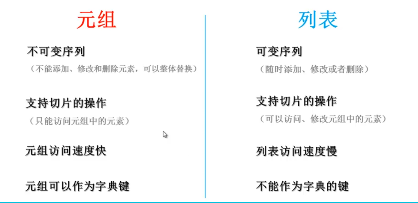1、列表
列表:使用方括号将用逗号分隔不同的数据项括起来。 可以存储不同类型的数据。
list = [1,‘a’,[1,2 ],“python”]
创建列表
list = [obj0,obj1]
list1 = [1,2,3]
list2 = ["C","python","java"]
list3 = [] #创建一个空列表
访问列表
list[index]
list = ['a', 'b', 'c', 'd']
print("list[1] :",list[1]) #获取索引为1的元素
print("list[1] :",list[-1]) #获取倒数第一个元素
print(list[1:3:1]) #使用切片获取元素 [1,3),步长为1
#结果:
list[1] : b
list[-1] : d
['b', 'c']
遍历列表
list = ["C","python","java","php"]
for i in list:
print(i)
#结果:
C
python
java
php
遍历列表(需要获取索引值)enumerate()
list = ["C","python","java","php"]
for index,item in enumerate(list):
print(index,item)
#结果:
0 C
1 python
2 java
3 php
添加、修改列表
list.append(obj) 在列表末尾添加新的对象
list.insert(index,obj) 添加元素到指定位置
list[index] = obj 修改元素
oidlist.extend(newlist) 添加列表
list = [1,2,3,4,5,6]
list1 = [7,8,9]
list.append("python") #在列表末尾添加新元素
list.insert(1,"a") #添加“a”索引为1
list[0] = "b" #修改索引为0的元素
list.extend(list1) #添加list1
list.pop() #移除列表中的最后一个元素,并返回
list.pop(1) #移除列表中索引为1的元素,并返回
#列表的变化依次 为:
[1, 2, 3, 4, 5, 6, 'python']
[1, 'a', 2, 3, 4, 5, 6, 'python']
['b', 'a', 2, 3, 4, 5, 6, 'python']
['b', 'a', 2, 3, 4, 5, 6, 'python', 7, 8, 9]
['b', 'a', 2, 3, 4, 5, 6, 'python', 7, 8]
['b', 2, 3, 4, 5, 6, 'python', 7, 8]
获取列表的最大、最小值、长度、和
max(list)
min(list)
len(list)
sum(list)
list = [12,14,52,84,34,13,21]
print("max(list):",max(list)) #获取最大值
print("min(list):",min(list)) #获取最小值
print("len(list):",len(list)) #获取列表长度
print("sum(list):",sum(list)) #获取元素之和
#结果:
max(list): 84
min(list): 12
len(list): 7
sum(list): 230
对列表进行排序
list.sort() 升序,原列表改变
list.sort(key =str.lower,reverse=False) 不区分字母大小写升序, reverse=True降序 原列表改变
sorted(list, key =str.lower,reverse=False) 不区分字母大小写升序, reverse=True降序 原列表不变
list1 = [11,8,45,72,31,43,6,1]
list2 = ["a","B","c","D","e","f","G"]
list1.sort() #升序排列
list2.sort() #升序排列
print(list1)
print(list2)
#结果 原序列改变
[1, 6, 8, 11, 31, 43, 45, 72]
['B', 'D', 'G', 'a', 'c', 'e', 'f']
=================================================================
list = ["a","B","c","D","e","f","G"]
list.sort(key = str.lower,reverse = True) #不区分大小写降序排列
print(list)
#结果
['G', 'f', 'e', 'D', 'c', 'B', 'a']
=================================================================
list = ["a","B","c","D","e","f","G"]
a = sorted(list, key =str.lower,reverse=True) #不区分大小写降序排列
print(a)
print(list)
#结果
['G', 'f', 'e', 'D', 'c', 'B', 'a']
['a', 'B', 'c', 'D', 'e', 'f', 'G']
列表推导式
list = [expression for i in fun if conditionj]
随机生成10个0到20的数,组成列表
import random
list1 = [random.randint(0,20) for i in range(10)]
print(list1)
#结果
[9, 13, 10, 1, 2, 16, 11, 0, 3, 9]
删除列表
del list()
list.remove(obj)
list1 = ['a', 'b', 'c', 'd']
list2 = [1,2,3,4,5,6]
list3 = ['C', 'java','python']
del list2[2] #删除list2中索引为2的元素
list3.remove("python") #删除list3中"python"元素
del list1 #删除list1
#结果:
list2 = [1, 2, 4, 5, 6]
list3 = ['C', 'java']
list1被删除
其余操作
二维列表:
list = [[1,2,3],[11,12,13],[21,22,23]]
list = [12,41,31,54,12,78,31,71,12]
print(list.count(12)) #获取元素12出现的次数
print(list.index(71)) #获取71对应的索引
#结果:
3
7
list1 = [1,2,3]
list2 = [4,5,6]
print(list1+list2) #列表相加
print(list1*3) #重复列表
print(1 in list1) #判断元素是否在列表中
#结果:
[1, 2, 3, 4, 5, 6]
[1, 2, 3, 1, 2, 3, 1, 2, 3]
True
2、元组
元组和列表相似,差异在于元组是只读的,不能修改,用“()”表示。
tuple = (‘a’, ‘b’, ‘c’, ‘d’)
元组和列表的区别

创建元组
tuple = ()
tup1 = (1,2,3,4,5,6)
tup2 = ("C","python","java")
tup3 = () #创建一个空元组
tup4 = (1,) #只有一个元素,需要在后面加上',',否则会当成整型处理
访问元组
tuple(index)
tup1 = (1,2,3,4,5,6)
print(tup1[2]) #获取索引为2的元素
print(tup1[-2]) #获取倒数第二个元素
print(tup1[0:5:2]) #使用切片获取元素 [0,5),步长为2
#结果:
3
5
(1, 3, 5)
添加、修改元组
元组中的元素值是不允许修改的,但可以连接组合
tup1 = (12,34,56)
tup2 = ('abc', 'xyz')
tup3 = tup1 + tup2 #
print (tup3)
print(tup1*2)
#结果:
(12,34,56, 'abc', 'xyz')
(12,34,56, 12,34,56)
获取元组的最大、最小值、长度、和
和列表相似
tup = (8,12,45,34,21,84,99,6)
print("max(tup):",max(tup)) #获取最大值
print("min(tup):",min(tup)) #获取最小值
print("len(tup):",len(tup)) #获取元组长度
print("sum(tup):",sum(tup)) #获取元素之和
#结果:
max(tup): 99
min(tup): 6
len(tup): 8
sum(tup): 309
删除元组
元组中的元素不能删除,可以使用del语句来删除整个元组。
tup = (1,2,3,4,5,6)
del tup #删除整个元组
3、字典
最外面用{},每一组用”:“连起来,各组用”,“隔开,可存储任意类型对象。值可以取任何数据类型,但键必须是不可变的,可以用数字,字符串或元组充当,不能为列表。
dictionary = {‘key1’:‘value1’ , ‘key2’:‘value2’ , ‘key3’:‘value3’ , ‘key4’:‘value4’}
创建字典
创建字典: {1:‘one’ , 2:‘two’ , 3:‘three’ ,4:‘four’}
#直接生成
dict = {1:'one' , 2:'two' , 3:'three' ,4:'four'}
==========================================
#由两个列表生成
list1 = [1,2,3,4]
list2 = ['one','two','three','four']
dictionary = dict(zip(list1,list2))
==========================================
dict = {} #创建空字典
dictionary=dict.fromkeys(key) 只有键 值暂定
key = [1,2,3,4]
dictionary=dict.fromkeys(key)
print(dictionary)
#结果:
{1: None, 2: None, 3: None, 4: None}
访问字典
通过键获取字典元素: dict(key)
dict = {1:'one' , 2:'two' , 3:'three' ,4:'four'}
print("dict[1]:",dict[1]) #1表示键,并非索引
#结果:
dict[1]: one
dictionary.get(key,default)
key存在时,返回键对应的值,不存在时返回default,默认为None。
dict = {1:'one' , 2:'two' , 3:'three' ,4:'four'}
print("dict[1]:",dict[1])
print(dict.get(5))
print(dict.get(5,"字典中无对应元素"))
#结果:
dict[1]: one
None
字典中无对应元素
遍历字典:
dictionary.item()
dict = {1:'one' , 2:'two' , 3:'three' ,4:'four'}
for key,value in dict.items():
print(key,"对应",value)
#for key in dict.keys():
# print(key) 只输出key(value同理)
#结果:
1 对应 one
2 对应 two
3 对应 three
4 对应 four
添加、修改字典
dictionary[key] = value
dict = {1:'one' , 2:'two' , 3:'three' ,4:'four'}
dict[5] = "five" #增加
dict[1] = "first" #修改
字典依次为:
{1: 'one', 2: 'two', 3: 'three', 4: 'four', 5: 'five'}
{1: 'first', 2: 'two', 3: 'three', 4: 'four', 5: 'five'}
删除字典
del
clear
dict1 = {1:'one' , 2:'two' , 3:'three' ,4:'four'}
del dict1[1] #删除key为1的元素
print(dict1)
dict1.clear() # 清空字典
print(dict1)
del dict1 # 删除字典
print(dict1)
#结果:
{2: 'two', 3: 'three', 4: 'four'}
{}
#字典被删除,不存在,报错。
其余函数
len(dict) 计算字典元素个数,即键的总数
dict.copy() 返回一个字典的浅复制
key in dict 如果键在字典dict里返回true,否则返回false
dict1 = {1:'one' , 2:'two' , 3:'three' ,4:'four'}
print(len(dict1)) #计算字典元素个数,即键的总数
dict2 = dict1.copy()
print(dict2)#返回一个字典的浅复制
print(3 in dict1) #如果键在字典dict里返回true,否则返回false
#结果:
4
{1: 'one', 2: 'two', 3: 'three', 4: 'four'}
True
4、集合
用大括号 { } 或者 set() 函数创建集合,无序,不重复,不支持索引。
set = {‘a’, ‘b’, ‘c’, ‘d’}
创建集合
创建字典 set = {‘a’, ‘b’, ‘c’, ‘d’}
set = {'a', 'b', 'c', 'd'} #直接生成
==========================================
list = ['a', 'b', 'c', 'd']
set1 = set(list) #使用列表生成集合
==========================================
set() #创建空集合
添加、删除集合
setname.add() #添加元素
setname.remove() # 删除指定元素
setname.pop() # 随机删除元素
setname.clear() # 清空集合
集合的交、并、差、对称差集
交集 & 并集 | 差集 - 对称差集 ^
set1 = {1,2,3,4,5,6}
set2 = {4,5,6,7,8,9}
print(set1&set2)
print(set1|set2)
print(set1-set2)
print(set1^set2)
#结果
{4, 5, 6}
{1, 2, 3, 4, 5, 6, 7, 8, 9}
{1, 2, 3}
{1, 2, 3, 7, 8, 9}
其余函数
copy() 拷贝一个集合
difference() 返回多个集合的差集
intersection() 返回集合的交集
intersection_update() 删除集合中的元素,该元素在指定的集合中不存在。
isdisjoint() 判断两个集合是否包含相同的元素,如果没有返回 True,否则返回 False。
issubset() 判断指定集合是否为该方法参数集合的子集。
issuperset() 判断该方法的参数集合是否为指定集合的子集
symmetric_difference() 返回两个集合中不重复的元素集合。
symmetric_difference_update() 移除当前集合中在另外一个指定集合相同的元素,并将另外一个指定集合中不同的元素插入到当前集合中。
union() 返回两个集合的并集
最后
以上就是热情水壶最近收集整理的关于Python中的列表、元组、字典、集合详解1、列表2、元组3、字典4、集合的全部内容,更多相关Python中内容请搜索靠谱客的其他文章。








发表评论 取消回复